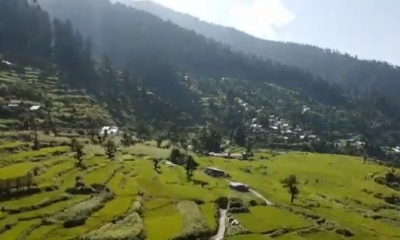By Sheikh QayoomSrinagar, Sep 7 : Kashmir’s fast shrinking countryside is witness to human greed and short-sightedness of planners.
Just two decades back, one would get a divine feeling of entering the lap of nature as Srinagar city was surrounded by vast, lush green paddy fields and crystal clear water bodies.
Bathers would drink handfuls of clean water in the Dal Lake which is situated in the heart of Srinagar city.
Within less than three decades, this lake has lost its grandeur and purity despite the huge effort put in by the governments to restore this water body to its old glory.
Bathers are reported to develop skin allergies and drinking the water of the Dal Lake is now considered a gastroenterologist’s goldmine.
Fast growing cities and towns have eaten up the rural greenery in all the 10 districts of the Valley, Srinagar being the worst affected of all.
Monoliths of concrete have come up around and inside Srinagar city and the newfound greed to construct shopping malls and multi-storeyed business complexes in the suburbs has deprived posterity from witnessing the city’s glory except in the photo-albums of their grandparents.
The ecological disaster of Srinagar city is in fact much older than just the last three decades.
In the 1960s, a mindless administrative decision was taken to fill up the ‘Nallah Mar’ that went round the old Srinagar city.
Srinagar till then was called the ‘Venice of Asia’ because of this serpentine canal that formed a fabulous waterway on the banks of which most of the city’s commercial activities took place.
It was a magical waterway in which boats carrying goods would move as buyers would line up at different shopping points.
A macadamised road has replaced the canal on which the security forces and the miscreants kept battling with stones and tear smoke shells during the peak years of violence.
Incidentally, the first burst of the separatist automatic gunfire was also heard on this road in 1989.
Till a few months back, the conversion of agricultural land for any other purpose, including house construction and commercial activity, was banned under the law.
This ban order was recently relaxed permitting the conversion of agricultural land for other use after paying a fixed amount of revenue to the government.
The protection of the shrinking agricultural land in the Valley had already given the authorities sleepless nights as encroachers and greedy land brokers kept on selling these protected pieces of land on the sly.
Now that the same can be legally converted for other purposes, how fast would Valley’s agricultural fields last is anybody’s guess.
Does Kashmir have so much potential for commercial activities that crores of Rupees are being spent each day for construction of shopping malls and complexes?
Interestingly, the experts believe that these real estate ownerships have become a convenient method of parking your money.
“Say for example, you construct a shopping complex that might not fetch you the investments in the first few years.
Given the normal escalation and appreciation, you would earn 100 times more on such investments over the years than any bank can pay you on that amount,” said a financial expert.
Thanks to the efficient public distribution system, rice, the staple food of the local people, is available at comparatively lower price through the government run ration depots.
Rice grown locally costs much more than the same quantity available at the government run ration depot.
Farmers have started a novel practice in Kashmir.
They sell their own produce of rice and buy their annual requirement on a monthly basis from the government ration depots.
Only the richer sections of the local society are now seen eating the locally grown grain.
While everybody is driven by greed to earn more by parking money in real estate and lands are sold and purchased at exorbitant rates, nobody seems to give a damn to the green countryside of Kashmir nor its glistening streams and springs.
sq/dpb
#Kashmirs #Srinagar







